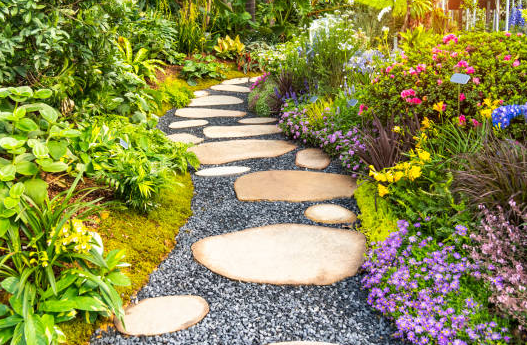Get ready to grow! By following these simple instructions, you can create beautiful flower arrangements all summer long. Planting flowers in your garden is more than just digging a hole and putting in some plants. Anyone can have their own flower bed and decorate their home with flowers they’ve grown themselves. Here’s what you need to know about planting flowers.

1. Choose the Right Location
Unless you’re planting enough flowers to fill a large space, try to place your flower bed somewhere close for easy enjoyment, like along a pathway or around your mailbox. The reason for planting in an accessible area is that you can easily water your plants during dry spells or frost, and you can also expand existing boundaries, such as using a fence or planting around small trees to add interest—otherwise, these areas will likely be neglected. The most important thing to consider is whether your flowers will thrive in the chosen spot. Most plants need good drainage, which means the area shouldn’t collect standing water, as moist soil will rot the roots. For most annuals, at least 6 hours of direct sunlight each day is essential.
2. Select Your Plants
However, there are exceptions if you choose the right plants. If you don’t have a well-draining spot, you can opt for varieties like coleus, impatiens, or pansies, which can tolerate moist conditions for a short time.
While most flowers require plenty of sunlight, varieties like begonias, impatiens, and sage can tolerate some shade. Violets, petunias, pansies, and eucalyptus even tolerate light frosts.
You can choose to plant perennials in addition to annuals, as they may come back year after year and grow larger with time.
Starting from seeds can be cheaper, but it takes more time. Some plants, like sunflowers and morning glories, don’t transplant well from pots. Before planting, remove the plants and their roots from the pots, making sure the roots are white and not too tightly packed—if they are, they won’t transplant well. Avoid purchasing plants that show signs of pests or disease, as they could spread throughout your garden.
3. Soil Preparation
A well-prepared soil bed is key to successful gardening, so don’t rush. There are two ways to prepare the soil.
One method is to remove the turf and cover the future garden area with compost. Then, dig a trench along the edge of the plot, placing the removed soil into the garden bed and digging inward until you reach the center. This will create enough space for the roots to establish themselves.
Another way to prepare the bed is by laying down a few layers of newspaper to suffocate the grass, then covering it with several inches of compost. Wait for a few seasons to allow the grass to die. This method takes more time but is ideal if you have tough turf (like St. Augustine grass) or stubborn weeds. It also preserves soil structure and beneficial organisms like earthworms.
4. Planting
Before planting, water the plants you’ve purchased from the nursery thoroughly to minimize transplant shock. You can place the plants in pots or plant them directly in the garden—try different designs to see which you like best.
For each plant, dig a hole the same depth as the root ball and twice as wide. Loosen the soil at the bottom of the hole to encourage the plant to grow strong, deep roots. Place the plant in the hole, ensuring the top of the root ball is level with the surrounding soil. Fill the hole with the soil you dug up, or better yet, use compost. After planting, apply 1–3 inches of mulch around the plant and water thoroughly to help the roots establish in the soil.
5. Fertilizing
While fertilizing may not be as urgent as watering, it helps your plants grow fuller and become more resistant to drought, pests, and other stressors. Not all fertilizers are good for flowers, so choose a fertilizer labeled for flower gardening or one with low nitrogen, as nitrogen promotes leaf growth but can hinder flower production. Both synthetic and organic fertilizers have their pros and cons. Synthetic fertilizers work quickly but can leach out of the soil or burn the plants. Organic fertilizers may take longer to show results but are generally considered safer for plants and gardeners. Always follow the instructions on the fertilizer packaging.
6. Weeding
Even well-prepared soil beds will have weeds, and poorly prepared beds will have even more. Weeds are not only unsightly but also steal moisture and nutrients from your plants, and they can harbor pests and diseases.
Avoid using chemical weed killers, as they can harm or kill nearby plants. Instead, pull the weeds by hand, grabbing them at the base of the soil, and remove them slowly. It’s best to compost the weeds so they don’t re-sprout. You can also use a hoe or tiller to remove new weeds quickly, but make sure to pull out the roots to prevent them from growing back.
7. Watering
All flower beds need regular watering for the first few weeks after planting, as the plants haven’t developed a strong enough root system yet. The best watering method is either drip irrigation or hand watering. With drip irrigation or soaker hoses, you water the soil directly instead of wetting the leaves, as moisture on the leaves can lead to disease or evaporate.
Another option is using a hose with a nozzle by hand. This is useful because it allows you to control exactly which plants need water and how much. Once the plants are established, only water when they show signs of drought stress, such as wilting or soft, droopy leaves.
With these basic steps, you can start creating your own vibrant flower garden! Happy gardening!

